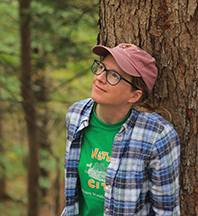Week of September 28, 2025 – October 4, 2025
by Anna Stunkel, Environmental Educator
Fall and spring have always been my favorite seasons, in large part because they are alive with color. These are times when big changes happen, and nature widely broadcasts seasonal transitions here in the northeast. In fall, you might notice all the colors of the rainbow! As a nature illustrator, I joke about closely observing colors and often matching them up with different colored pencil shades. For example, a leaf might look cadmium orange, then change to burnt sienna as it ages. As light and shadows play across the leaf’s surface, you may notice unexpected colors like dark indigo under the wavy edges. Noticing these colors helps us feel closer to nature, teaching us patience and focus.
Red Maples have some of the most vibrant autumn colors, especially if you visit a Red Maple swamp. The trail area between the two hillsides of the Valley Trail is a great place to find these brilliant leaves. As leaves become more dried out and crunchy, they develop a russet color and release the pleasant smell that we associate with fall. You might come across red apples in your travels to local apple orchards. We also have apple trees near the log cabin here at Baltimore Woods. While most apples are not native to North America, they provide a great food source for wildlife like deer, squirrels, and insects.
You might notice orange along the edges of Sugar Maple leaves, or dots of orange mushrooms that stand out in the leaf litter. Since we’ve had some much needed rain, fall fungi are popping up all over the forest. Monarch butterflies are migrating southwards to Mexico, and you might even spot these orange winged wonders traveling high against a blue sky.
Yellow is a common theme in nature’s fall color palette. Yellow leaves are especially striking as the sunlight hits them, and vast fields of goldenrod attract a plethora of insects– both hosts and pollinators that feed on them. Many migrating warblers also have yellow hues. While more subdued in fall than spring, these birds are still beautiful (and extra challenging for birders to identify!)
Green provides a cooler backdrop for the more fiery colors, and we can enjoy greenery for a little while longer before the real cold weather sets in. Along with green leaves and grasses, many grasshoppers are active in fall fields.
Blues are less obvious in fall, except in the deeper shadows among leaves. Oil beetles have been very active around Baltimore Woods lately, and these insects have a blue sheen. Watch out, because they release a nasty chemical that causes blisters to defend themselves. More constant cloud cover is on the way here in Central New York, so enjoy the contrast of blue skies and fiery fall leaves while you can!
If you venture into a wild open field at this time of year, New England Asters sometimes hide among the taller flowers, adding a pop of purple to the landscape. These lovely blossoms attract pollinators, like the many bumblebees that our field trip students enjoy watching along the Meadow Trail. You might also find purple hues in fall leaves, especially deeper bluish purple maple leaves.
There we go, all the colors of the rainbow! Can you think of any other fall findings to add? If you want to get creative with fall colors, I’ll be leading a program on painting fall leaves with acrylics this Thursday morning. We will use repurposed pieces of wood for painting. Hope to see you there!


